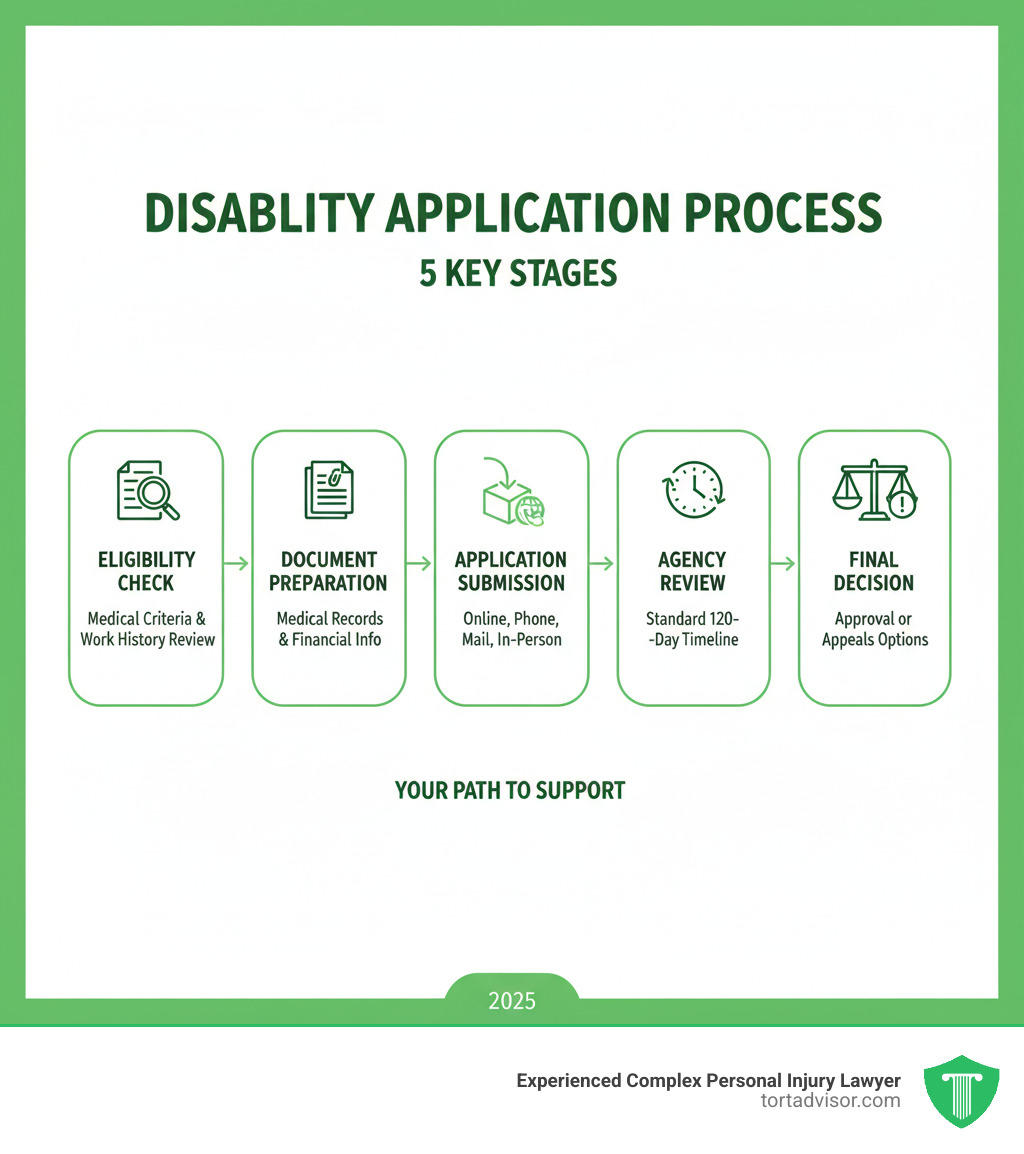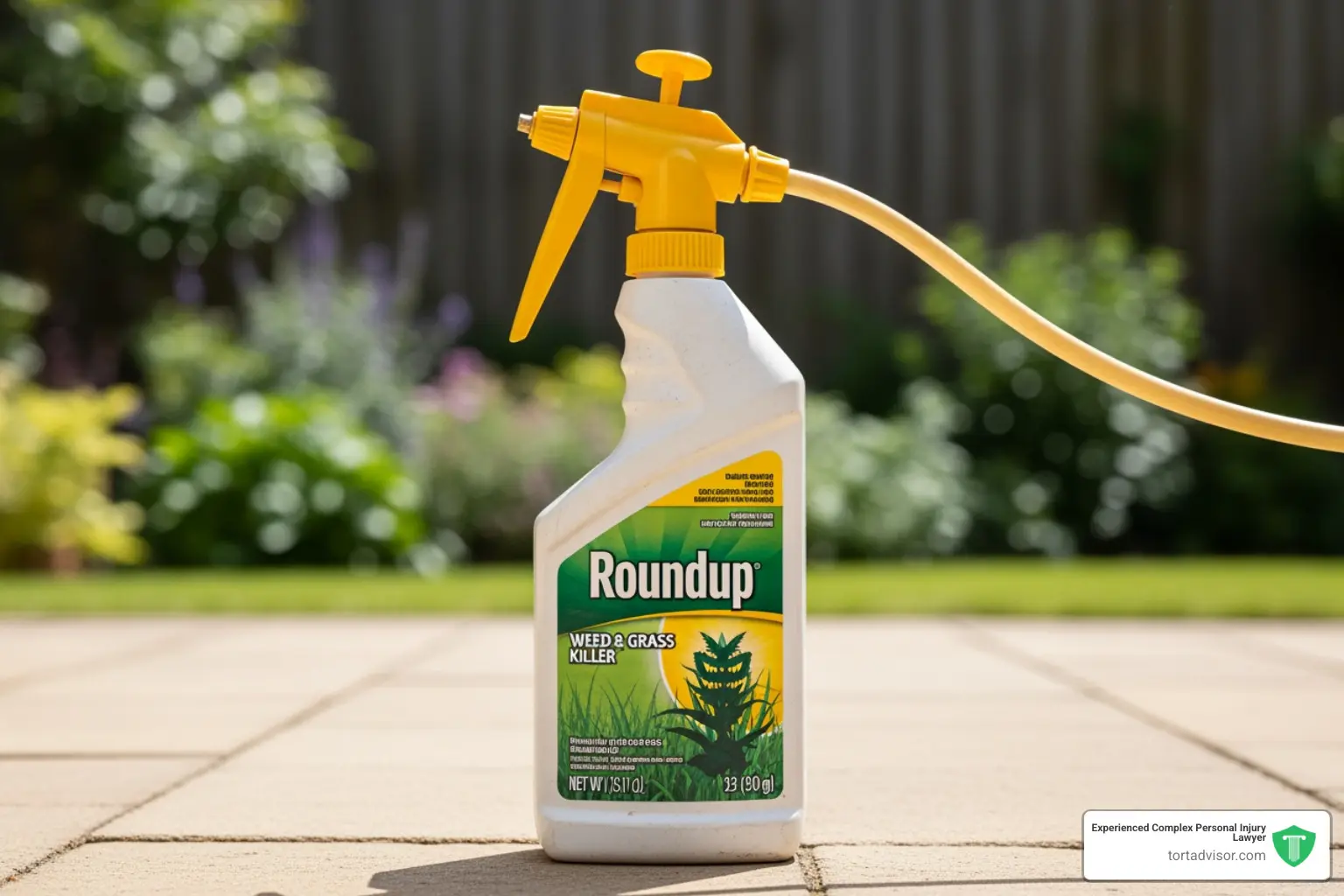


Why Understanding Your Disability Benefits Application Matters
Disability benefits application is a critical process for financial support when a medical condition stops you from working. Whether you’re applying for Social Security Disability Insurance (SSDI), Supplemental Security Income (SSI), Canada Pension Plan Disability (CPP-D), or provincial programs like ODSP, understanding the process is key.
Here’s what you need to know to get started:
- Multiple application methods – Apply online, by phone, in-person, or by mail.
- Standard processing time – Most applications take 4 months (120 days), though expedited options exist for terminal or grave conditions.
- High initial denial rates – Most first-time applications are denied, making accuracy crucial.
- Required documentation – You’ll need medical records, work history, and personal and financial information.
- Two-part process – Applications usually involve a general form and a separate medical assessment.
The reality is that applying for disability benefits is time-consuming and complicated. The waiting period can feel overwhelming when you’re already dealing with medical treatments and lost income. However, understanding the process before you start can significantly improve your chances of approval. Knowing what documents to gather and how to describe your condition helps you avoid the common mistakes that lead to denial.
A successful application means crucial financial support, while a denied claim means starting a lengthy appeals process. This guide walks you through every stage of the application, covering both U.S. and Canadian programs.
As Mason Arnao, I’ve spent years helping individuals steer complex systems. My goal is to break down this complicated process into simple, actionable steps that give you the best chance of success.

Simple guide to Disability benefits application terms:
- Denied disability claim
- Disability claim assistance
Understanding Your Options: Types of Disability Benefits
When a disability prevents you from working, several benefit programs can help, depending on your location and situation.
In the United States, two primary programs exist. Social Security Disability Insurance (SSDI) is for those who have worked and paid Social Security taxes. Supplemental Security Income (SSI) is a needs-based program for people with limited income and resources, regardless of work history.
In Canada, the Canada Pension Plan Disability (CPP-D) benefit is for those who have contributed to the Canada Pension Plan. The newer Canada Disability Benefit (CDB) supports low-income, working-age Canadians with disabilities. Provincial programs, like the Ontario Disability Support Program (ODSP), also provide financial assistance based on need.
Here’s a quick comparison to help you see the differences at a glance:
| Program | Administering Body | Funding Source | Basic Eligibility |
|---|---|---|---|
| U.S. – SSDI | Social Security Administration (SSA) | Payroll taxes (FICA) | Disabled, worked long enough, paid Social Security taxes |
| U.S. – SSI | Social Security Administration (SSA) | General tax revenues | Disabled, limited income and resources, regardless of work history |
| Canada – CPP Disability | Service Canada | Canada Pension Plan contributions | “Severe and prolonged” disability, made enough CPP contributions |
| Canada – CDB | Service Canada | Federal government | Disabled, low income, DTC eligible (or equivalent), 18-64 years old, Canadian resident |
| Canada – ODSP (Ontario) | Ontario Ministry of Community and Social Services | Provincial government (Ontario) | Ontario resident, 18+, significant disability, financial need |
Understanding which program fits your situation is the crucial first step. For personalized support, check out our resources on Disability Claim Assistance.
Who is Eligible to Apply?
Eligibility hinges on one key factor: your medical condition must significantly limit your ability to work. A diagnosis alone is not enough. The Social Security Administration (SSA) defines disability as the inability to perform any “substantially gainful activity” due to a medically determinable impairment expected to last at least 12 months or result in death. Canada’s CPP uses similar “severe and prolonged” language.
Your medical records are the foundation of your application. They must include:
- Diagnoses from qualified doctors.
- Treatment records, therapies, and surgeries.
- Lab results and imaging scans (X-rays, MRIs).
- A complete list of medications and their side effects.
- Statements from healthcare providers explaining how your condition limits your ability to work and perform daily activities.
The SSA’s “Blue Book” lists conditions that can automatically qualify, but you can still be approved if your impairment is medically equivalent to a listed condition.
Work history matters for insurance-based programs. For SSDI, you need enough “work credits,” generally 40 credits, with 20 earned in the last 10 years. For CPP Disability, you must have contributed in at least four of the last six years (or three of six if you have 25+ years of contributions).
Age can influence your application. While benefits aren’t age-restricted, the SSA gives more weight to age for applicants over 50, recognizing the difficulty of retraining for new work. For more details, the official Social Security Administration website is an excellent resource.
How Other Income Affects Your Eligibility
Your current income can impact your eligibility, especially for needs-based programs.
The most important concept is Substantial Gainful Activity (SGA). If you earn above a certain monthly amount, the SSA will determine you are not disabled. In 2024, the SGA limit is $1,550 per month ($2,590 if you’re blind). Earning more than this is a common reason for technical denial. You can find current limits on the SSA’s page for substantial gainful activity.
Supplemental Security Income (SSI) has strict income and resource limits. The SSA counts most money you receive, including gifts or free food and shelter, as “unearned income,” which can reduce your payment. You cannot have more than $2,000 in countable assets ($3,000 for a couple).
Ontario Disability Support Program (ODSP) is also needs-based, but some income types are partially or fully exempt. You must report all income honestly.
Good news: the Canada Disability Benefit (CDB) won’t reduce your provincial benefits. It is designed to supplement existing programs. If you receive ODSP, the CDB will not affect your eligibility for ODSP because it is treated as exempt income.
Your Step-by-Step Disability Benefits Application Guide
This section breaks down the application process into manageable steps. Careful preparation here can prevent delays and denials.
Gathering Your Essential Information and Documents
Think of this as building your case. The agency reviewing your application only knows what you provide in your documents. Your goal is to communicate your complete story.
You will need:
- Personal Identification: Social Security Number (SSN) or Social Insurance Number (SIN), birth certificate, and proof of citizenship. Include marriage certificates and children’s information if applicable.
- Medical Records: A complete list of all healthcare providers with contact details and dates of visits. Gather all related records: diagnoses, treatments, lab results, imaging scans, therapy notes, and psychological evaluations. Most importantly, include statements from your doctors explaining your functional limitations.
- Medication List: A current list of all medications, dosages, frequency, and side effects. Side effects can be as limiting as the condition itself.
- Work History: A 15-year work history with job titles, dates, duties, earnings, and reasons for leaving.
- Financial Information: Recent tax returns (W-2s or self-employment), bank account information for direct deposit, and details of any other benefits you receive.

Organize these documents in a binder or digital folder. Complete documentation means a faster decision.
Choosing Your Disability Benefits Application Method
You have several options for submitting your disability benefits application.
- Online: This is the fastest method. The U.S. SSA portal lets you apply for Social Security benefits online. In Canada, you can apply for CPP Disability Benefit through your My Service Canada Account (MSCA).
- By Phone: If you prefer guided assistance, you can apply over the phone. For U.S. Social Security, call 1-800-772-1213. In Canada, contact Service Canada.
- In Person: For face-to-face help, visit a local Social Security Field Office or a Service Canada centre. It’s best to call ahead for an appointment.
- By Mail: Paper forms are available to print and mail. Always use a trackable mailing service and keep copies of everything you send.
Regardless of the method, always keep copies of your entire application.
Tips for an Accurate and Complete Disability Benefits Application
Attention to detail is critical for a strong application.
- Double-check everything: Ensure all names, numbers, and dates are correct. Small errors cause delays.
- Be thorough and detailed: Don’t just say “I have back pain.” Describe how it impacts your daily life. Explain how you can’t sit for more than 15 minutes, lift a gallon of milk, or get dressed without difficulty. Paint a specific picture of your limitations regarding sitting, standing, lifting, concentrating, and interacting with others. The more vivid the details, the stronger your case.
- Meet all deadlines: Respond immediately to any requests for more information. Missing a deadline can get your application closed, forcing you to start over.
- Keep copies of everything: Maintain a complete record of all forms and correspondence. This is your proof if anything gets lost.

Your application is your chance to make your case. Take your time, be meticulous, and ask for help if you need it. The effort now can save you from a lengthy appeals process later.
After You’ve Applied: What to Expect
You’ve submitted your disability benefits application. Now comes the waiting period, which can be stressful. Understanding the process can help you manage this time.
Application Timelines and How to Check Your Status
Reviewing an application is a thorough process that takes time.
- United States (SSDI/SSI): The SSA typically takes 3 to 5 months for an initial decision, though complex cases can take longer.
- Canada (CPP-D/CDB): Service Canada aims for a decision within 120 calendar days (about 4 months).
- Ontario (ODSP): The process is multi-stage, with decisions on financial and medical eligibility taking up to 15 and 90 business days, respectively, after initial contact.

You can check your application status online instead of waiting anxiously.
- U.S. Applicants: Use your my Social Security account to check your status.
- Canadian Applicants: Your My Service Canada Account (MSCA) is the best place for updates on CPP-D or CDB applications. For ODSP, you can check your application status online or log into MyBenefits.
While it’s tempting to call frequently, checking online is more efficient.
Special Processing for Terminal or Grave Conditions
For those with life-threatening conditions, expedited pathways exist.
- United States: The Compassionate Allowances program fast-tracks applications for certain severe conditions like aggressive cancers or ALS. Approval can take just days or weeks.
- Canada: The CPP Disability program offers expedited processing for terminal illnesses (death likely within 6 months), aiming for a decision within 5 business days. For grave conditions (rapidly progressive), the target is 30 calendar days.
If this applies to you, ensure your medical records clearly state the terminal or grave nature of your illness. Use the specific Terminal Illness Application for CPP Disability form (ISP-2530A) to speed up the process.
What to Do If Your Disability Benefits Application is Denied
Most first-time disability applications are denied. This is frustrating, but a denial is not the end. Many people who are eventually approved were denied at first.
Common reasons for denial include:
- Insufficient medical evidence.
- The condition is not considered “severe and prolonged.”
- Earning too much money (exceeding SGA limits).
- Failure to follow prescribed treatment or cooperate with the agency.
If your application is denied, you have the right to appeal. You typically have 60 days from receiving the denial letter to file.
The U.S. appeals process has several levels:
- Reconsideration: A new examiner reviews your case and any new evidence.
- Hearing: You present your case in person to an Administrative Law Judge (ALJ).
- Appeals Council: You can ask the council to review the ALJ’s decision.
- Federal Court: The final step is to file a lawsuit in federal court.
Don’t give up. The appeals process is your chance to strengthen your case, often with the help of an experienced attorney. If you’ve been denied, learn what to do after a Denied Disability Claim and consider getting professional help.
Frequently Asked Questions about Disability Applications
Here are answers to some common questions about the disability benefits application process.
What is the main difference between Social Security Disability Insurance (SSDI) and Supplemental Security Income (SSI)?
The key difference is how they are funded and who they are for.
- SSDI (Social Security Disability Insurance) is an earned benefit. You qualify based on your work history and the Social Security taxes you’ve paid. There are no income or resource limits, but you cannot earn above the Substantial Gainful Activity (SGA) threshold.
- SSI (Supplemental Security Income) is a needs-based program funded by general tax revenues. It is for disabled adults and children with very limited income and resources, regardless of work history.
It is possible to qualify for both programs at the same time.
How does the new Canada Disability Benefit (CDB) affect provincial programs like ODSP?
This is great news for Canadians. The federal Canada Disability Benefit (CDB) is designed to supplement, not replace, existing provincial disability programs. For Ontario residents, this means the CDB will not affect your eligibility for ODSP or reduce your ODSP payment amount. The CDB is treated as exempt income, allowing you to receive the full value of both benefits.
Can I work while applying for disability benefits?
Yes, but you must be careful about how much you earn. The Social Security Administration uses the “Substantial Gainful Activity” (SGA) rule. If your gross monthly earnings are above the SGA limit ($1,550 in 2024 for non-blind individuals), your claim will likely be denied on a technicality, no matter how severe your medical condition is. Keep detailed records of your hours and earnings if you are working part-time. If you are near the SGA limit, consider consulting a disability attorney.
If you’re feeling overwhelmed by the complexity of your situation or if you’ve already received a denial, expert help is available. Tort Advisor connects individuals with experienced attorneys who understand these nuances and can fight for the benefits you deserve. Find out if you have a case for an SSDI Lawsuit.
Conclusion
You’ve made it to the end of this guide, and that alone shows your determination. The disability benefits application process is detailed, but it is manageable. By understanding the requirements, gathering your documents, and submitting a thorough application, you give yourself the best possible chance of approval.
If your application gets denied, don’t lose hope. Denials are incredibly common, even for people who clearly qualify. The appeals process exists to give you additional opportunities to present your case and provide more evidence.
This is where having an experienced disability attorney makes all the difference. They know what evidence is needed and how to steer the complex appeals system, preventing mistakes that can cause long delays.
At Tort Advisor, we connect people with highly skilled attorneys who specialize in disability law and have proven track records. They are passionate about helping disabled individuals get the financial support they deserve.
You don’t have to face this alone. Whether you’re just starting your application, waiting for a decision, or dealing with a denial, expert legal help is available. Find out if you have a case for an SSDI Lawsuit and let us connect you with an attorney who can fight for the benefits you deserve.
Free Confidential Case Evaluation
Complete the short form below to get an immediate FREE case review with an expert in your specific claim. Don't wait, your case could be time sensitive to file a claim.
Related Posts
Did a North Dakota product cause harm? Understand product liability, your rights, and how to take action for defects.
Get justice for clergy abuse. Find an expert Priest abuse lawyer to navigate complex laws and hold institutions accountable.
Diagnosed with meningioma after Depo-Provera? Understand potential Depo-Provera lawsuit settlements, risks, & how to claim compensation.
Uncover the truth about uber sexual assault cases. Learn about the alarming scale, Uber's accountability, and legal options for justice.
Facing wildfire losses? Discover the best wildfire lawsuit attorneys in California to fight for your full recovery and justice.
Exposed to Roundup & diagnosed with NHL? Discover how to sue Monsanto, understand eligibility, & seek compensation. Your guide to justice.





